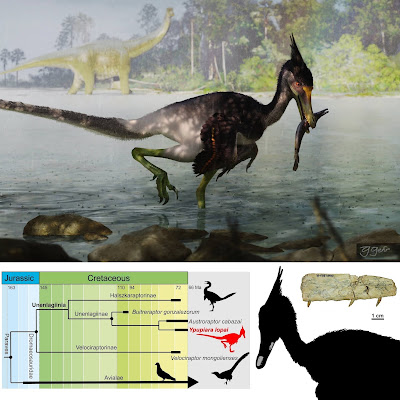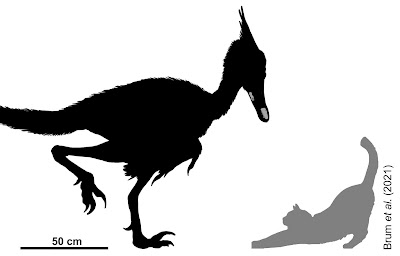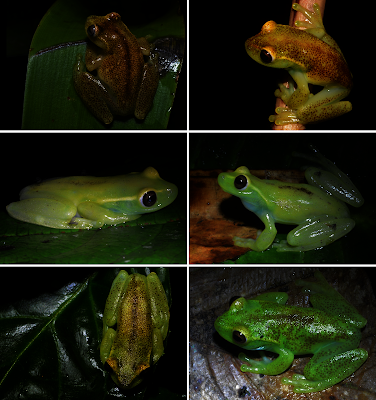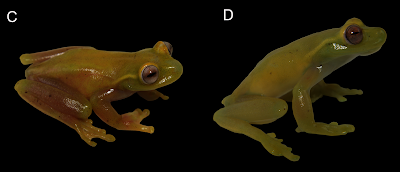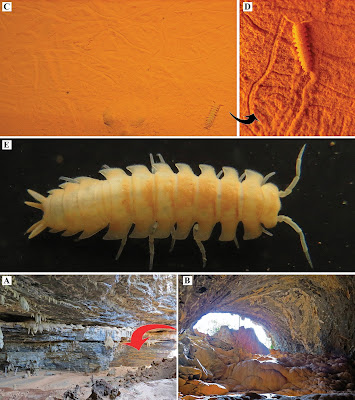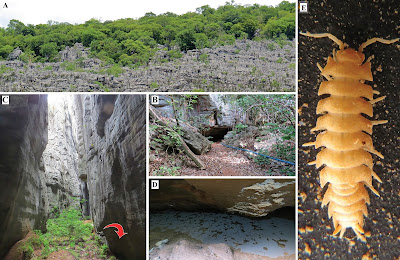[Most Recent Entries] [Calendar View]
Friday, August 6th, 2021
| Time | Event | ||||||
| 3:59a | [Paleontology • 2021] Ypupiara lopai • A New Unenlagiine (Theropoda, Dromaeosauridae) from the Upper Cretaceous of Brazil
Abstract The record of unenlagiines in Brazil, except for one dorsal vertebra, is still under debate based on isolated teeth. Here, we describe Ypupiara lopai gen. et sp. nov., the first dromaeosaurid species from Brazil, from the Maastrichtian of the Bauru Group, Paraná Basin. The specimen consists of a partial right maxilla (with three teeth in loci) and a right dentary. Ypupiara is characterized by a restricted number of neurovascular foramina on the lateral surface of the maxilla, a rectangular and anteroposteriorly expanded interdental plate, and a labiolingual compression of the teeth, which have a labiolingual diameter more than 3/5 of the rostrocaudal diameter. Our phylogenetic analysis recovers Ypupiara as an unenlagiine based on the fluted teeth and places it as the sister taxon of Austroraptor due to the ratio of the labiolingual and mesiodistal diameters of the teeth being more than 3/5. We also erect the new group Unenlagiinia, which includes Unenlagiinae and Halszkaraptorinae. Ypupiara nests within Unenlagiinia based on the widely spaced teeth and the lack of mesial and distal carinae in the maxillary teeth. The morphology of the teeth is similar to Buitreraptor, although the proportions are markedly distinct. The teeth and comparisons with other Unenlagiinia also support fish being part of the diet for Ypupiara. We also performed a parsimony analysis of endemicity, which suggested that the presence of unenlagiines in Brazilian Upper Cretaceous outcrops is explained by dispersion or extinction events. The new species provides new information on the evolution of Gondwanan dromaeosaurids, and its preserved teeth provide new data to enable the assignment of isolated dromaeosaurid teeth from the Bauru Group. DINOSAURIA Owen, 1842 THEROPODA Marsh, 1881 COELUROSAURIA Huene, 1914 MANIRAPTORA Gauthier, 1986 DROMAEOSAURIDAE Matthew & Brown, 1922 UNENLAGIINIA nov. Included clades: Unenlagiinae (sensu Bonaparte 1999) and Halszkaraptorinae (sensu Cau et al. 2017). Branch-based definition: All taxa closer to Unenlagia comahuensis Novas & Puerta, 1997 and Halszkaraptor escuilliei Cau et al., 2017 than to Microraptor zhaoianus (Sloan, 1999) or Dromaeosaurus albertensis Matthew & Brown, 1922. UNENLAGIINAE Bonaparte, 1999 Genus YPUPIARA nov. Type species: Ypupiara lopai sp. nov., type by monotypy. Derivation of name: ‘Ypupiara’, which means ‘the one who lives in the water’, an allusion to a Tupian myth about an aquatic creature. This also alludes to the inferred fish diet of Ypupiara. Ypupiara lopai sp. nov. Derivation of name: The specific epithet ‘lopai’ is in honour of Alberto Lopa (of the former Divisão de Geologia e Mineralogia, Departamento Nacional de Produção Mineral–DNPM of Peirópolis). He is responsible, together with Llewellyn I. Price, for starting the systematic palaeontological exploration of the region of Peirópolis, Minas Gerais state, and for recovering most of the material studied by Price. In addition, Alberto Lopa also recovered the fossil material studied here.
Conclusion: Specimen DGM 921-R represents a new species, Ypupiara lopai gen. et sp. nov., that can be recognized as an unenlagiine and which exhibits a combination of features observed in both Buitreraptor gonzalezorum and Austroraptor cabazai. The dental features, however, share more morphological similarities with B. gonzalezorum. The recovery of such cranial material with associated teeth is important to diagnose and trace comparisons with the dromaeosaurid teeth from Bauru Group outcrops, and as an indicator of the diversity of these small theropods. Such an unenlagiine occurrence in the Campanian–Maastrichtian intervals of Brazil indicates that the lineage was present not only in the Neuquén Basin (Argentina), but also in the Upper Cretaceous of the Paraná Basin (Brazil). Arthur S. Brum, Rodrigo V. Pêgas, Kamila L. N. Bandeira, Lucy G. Souza, Diogenes A. Campos and Alexander W. A. Kellner. 2021. A New Unenlagiine (Theropoda, Dromaeosauridae) from the Upper Cretaceous of Brazil. Papers in Palaeontology. DOI: 10.1002/spp2.1375 | ||||||
| 8:27a | [Herpetology • 2021] Hyloscirtus conscientia • A New Andean Treefrog (Anura: Hylidae: Hyloscirtus bogotensis group) from Ecuador: An Example of Community Involvement for Conservation
Abstract We provide several lines of evidence to delimit a new species of Hyloscirtus and define its phylogenetic position inside the Hyloscirtus bogotensis group. The new species is the sister taxon to Hyloscirtus mashpi and is related to a clade formed by H. alytolylax and a putative new species from the province of El Oro in, southwestern Ecuador. Hyloscirtus conscientia sp. nov. is described from the montane forests of the Mira River basin in the extreme northwestern Ecuador. The new species is characterized as follows: tympanic annulus conspicuous, tip of snout in dorsal view subacuminate, middorsal stripe formed by melanophores larger and less dense, dorsal skin with individual iridophores forming dots, scarcely distributed across dorsum. Our study also highlights the importance of the Mira River Valley as a biogeographic barrier; suggesting research efforts north and south of the valley are likely to reveal additional endemic cryptic diversity. Finally, our partnership with Reserva: The Youth Land Trust, Rainforest Trust and EcoMinga Foundation has produced a novel and meaningful way to connect young people with biodiversity discovery and habitat conservation.
Hyloscirtus conscientia sp. nov. Proposed standard Spanish name: Rana nubular torrenticola de Chical Proposed standard English name: Chical Nubulous Stream-Frog Diagnosis. Hyloscirtus conscientia sp nov. is characterized by the following combination of characters: (1) adult males small (SVL 29.6–33.3 mm, mean = 31.0 ± 1.0, n = 14), females (SVL 34.7–40 mm, mean = 37.3 ± 2.6mm, n = 3); (2) body relatively slender; (3) snout subacuminate in dorsal view and rounded in lateral view; (4) in life, dorsum usually pale yellowish-green, usually with a thin brown mid-dorsal stripe; (5) axillar and inguinal regions light yellowish-green; (6) mental gland present in males, pigmented in some individuals; (7) upper lip lacking white stripe; (8) parietal peritoneum white, visceral peritonea transparent; (9) iris grayish-brown to copper brown with thin black reticulation; (11) nuptial pad absent; (13) tympanic membrane pigmented as surrounding skin; tympanic annulus rounded and visible; (14) cream supraocular, supratympanic, and canthal stripes usually present; brown interorbital stripe usually present; (15) ulnar fold and tarsal stripe absent or inconspicuous; (16) calcar tubercle absent; (17) supracloacal fold low, with few iridophores; (18) low tubercles scattered around and below cloaca; (19) bones in life white; (20) elliptical prepollex not modified as a projecting spine; (21) dentigerous processes of vomers prominent, slightly curved, with a discernible gap and 10–14 teeth each; and (22) advertisement call with 5 or 6 notes, call duration = 470–632 ms, and dominant frequency = 2.93–3.10 kHz.
Natural history. Hyloscirtus conscientia was found along clean-water streams with many waterfalls in montane foothill cloud forest. The riparian forest included trees reaching 20 m high, covered by moss and epiphytes. Frogs were found at night, sitting on or under leaves and branches of Heliconiaceae, shrubs, trees, and ferns, at 30–350 cm above ground. Males were found calling while sitting under leaves in April, September and November. Hyloscirtus conscientia was found sympatric with Hyalinobatrachium sp. aff. valerioi, Espadarana prosoblepon, Rhaebo colomai, Atelopus coynei, and Pristimantis laticlavius. Etymology. The specific epithet of the new species is a noun in apposition derived from the imperative Latin “conscĭentĭa”. This name was proposed by Carolina Bustillos, a 19 years old Ecuadorian that participated in a global, public contest to select the species name. When explaining the species name, Carolina wrote: “We are at such a critical point in history, where the Earth and its species cannot continue to endure more exploitation and neglect by people. We are all part of this world and we must all have the consciousness to take care of it, to use less water, to use renewable energy sources, to consume less meat …. I think that this little frog should carry that message … the message of being aware of how wonderful this land is, with all its flora and fauna, and of being aware that we should take care of it and be grateful to it.” The Spanish and English common names of H. conscientia refer to the habitat and location in which the species is found, in the cloud forests near the small town of El Chical, Ecuador. In the Spanish name, the word “Nubular” was explained by Domenique Benítez (14 years old, Ecuador) as a short, simple, and easy-to-memorize word of her own invention. She wrote, “although this word does not exist, it quickly describes the frog’s habitat. I think the next generations should take into account that it is important to conserve species and name new ones in the future.” The word “nubular” makes reference to the constant presence of clouds (Spanish: nubes) on these forests. Conclusions: We provide several lines of evidence to delimit a new species of Hyloscirtus and define its phylogenetic position inside the Hyloscirtus bogotensis group. Our study also highlights the importance of the Mira River Valley as a conspicuous biogeographic barrier; therefore, research efforts north and south of the valley are likely to reveal additional endemic cryptic diversity. Finally, our partnership with Reserva: The Youth Land Trust, Rainforest Trust and EcoMinga Foundation has produced a novel and meaningful way to connect young people with biodiversity discovery and habitat conservation. Mario H. Yánez-Muñoz, Juan Pablo Reyes-Puig, Diego Batallas-Revelo, Callie Broaddus, Miguel Urgilés-Merchán, Diego F. Cisneros-Heredia and Juan M. Guayasamin. 2021. A New Andean Treefrog (Amphibia: Hyloscirtus bogotensis group) from Ecuador: An Example of Community Involvement for Conservation. PeerJ. 9:e11914. DOI: 10.7717/peerj.11914 | ||||||
| 10:29a | [Crustacea • 2021] Chaimowiczia tatus & C. uai • A New Iuiuniscinae Genus from Brazil (Isopoda: Oniscidea: Styloniscidae) with the Description of Two New Troglobitic Species Abstract A new genus of Styloniscidae, Chaimowiczia gen. nov., is described with two new species: Chaimowiczia tatus sp. nov. from Gruta do Padre cave (Santana, Bahia) and Chaimowiczia uai sp. nov. from Lapa d’água do Zezé cave (Itacarambi, Minas Gerais). The new genus and species were allocated into the subfamily Iuiuniscinae, hitherto monotypic, by the pronounced rectangular-shaped lateral pereonites epimera, dorsal surface smooth, body outline continuous without a gap between pereon and pleon, and pleonites 3 to 5 developed forming tips. The two species of Chaimowiczia gen. nov. differ in the shape of cephalon antennal lobes, pereonite 1 epimera, pleonite 5 posterior margin and uropod exopod and endopod proportion. Keywords: amphibious isopods, Cave fauna, Isopoda, Neotropics, São Francisco basin Family Styloniscidae Vandel, 1952 Genus Chaimowiczia gen. nov. Type species: Chaimowiczia tatus sp. nov. Diagnosis: Body non-volvational. Cephalon with antennal lobes, distinct suprantennal line bent in middle, vertex with lateral grooves. Body outline continuous with pereonites epimera well developed, widely separated, pleonites 1 and 2 bridge the gap between pereon and pleon, pleonites 3–5 with epimera well developed. Telson with subtriangular distal half depressed with rounded apex. Antennula of three articles covered with setae, distal article with two apical aesthetascs. Antenna with flagellum of three distinct articles covered with setae. Mandibles pars molaris large and projected. Maxillula outer ramus with entire teeth and two long and thick setose stalks; inner ramus with three penicils at apex. Maxilla inner lobe wider than outer lobe. Maxilliped basis trapezoidal; endite bearing one penicil between two strong teeth. Pereopods with unbranched dactylar setae. Genital papilla lanceolate. Male pleopod 1 exopod and endopod subequal in length, endopod two-jointed, with flagelliform distal article. Male pleopod 2 endopod with two thickset articles, distal one tapering apically. Etymology: The genus is named after Dr Flavio Chaimowicz, a physician who provided important contributions for the Brazilian speleology. Gender feminine. Chaimowiczia tatus sp. nov. Diagnosis: Chaimowiczia tatus sp. nov. is characterized by pereonite 1 epimera directed sideways; quadrangular antennal lobes; pleonites 3–5 epimera tips well developed, pleonite 5 short, not surpassing the apex of telson; and uropods endopod and exopod subequal in length. Etymology: The epithet “tatus” refers to the “Tatus II project”, an experiment of human permanency inside a cave held in 1987, conducted in Gruta do Padre cave. During the experiment, a group of speleologists stayed for 21 days inside the cave performing topographic and speleology surveys (Chaimowicz, 1987). Chaimowiczia uai sp. nov. Diagnosis: Chaimowiczia uai sp. nov. is characterized by the concave shape of pereonites epimera, with pereonite 1 epimeron directed frontward; round antennal lobes; pleonites 3–5 epimera with tips well developed, pleonite 5 surpassing apex of telson; and uropods endopod longer than exopod. Etymology: The epithet “uai” refers to the word often used by people from the state of Minas Gerais, Brazil, to express doubt, astonishment or surprise. Giovanna Monticelli Cardoso, Rafaela Bastos-Pereira, Leila Aparecida Souza and Rodrigo L. Ferreira. 2021. Chaimowiczia: A New Iuiuniscinae Genus from Brazil (Oniscidea, Synocheta, Styloniscidae) with the Description of Two New Troglobitic Species. Subterranean Biology. 39: 45-62. DOI: 10.3897/subtbiol.39.65305 |
| << Previous Day |
2021/08/06 [Calendar] |
Next Day >> |
